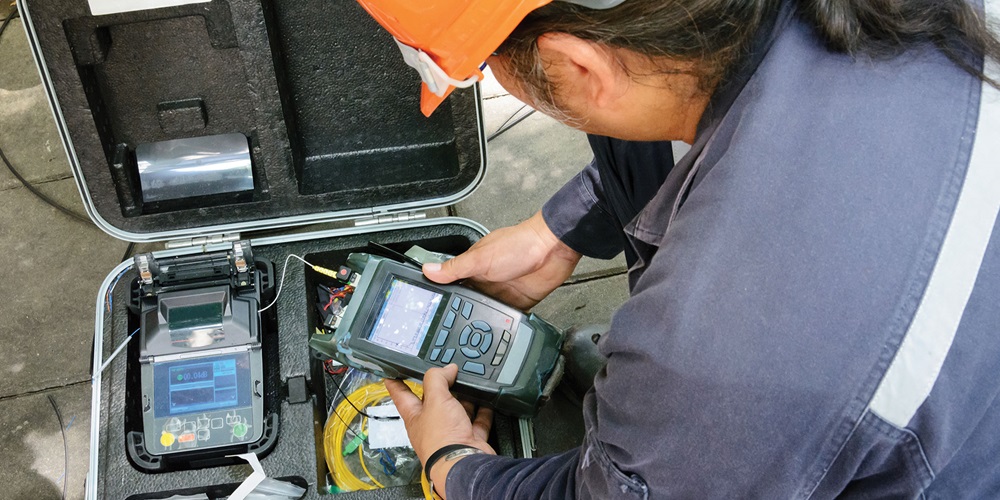The Role of Optical Fibre Screening in Ensuring Quality and Performance in Connectivity Solutions
In today's swiftly progressing digital landscape, the relevance of optical fiber testing can not be overstated, as it serves as a foundation for making sure the quality and performance of connection solutions. As modern technology proceeds to advance, the future of optical fibre screening positions intriguing obstacles and chances that merit closer evaluation.
Relevance of Optical Fibre Screening
The value of optical fiber screening can not be overemphasized in guaranteeing the stability and performance of interaction networks. As the backbone of modern telecoms, optical fibers assist in high-speed data transmission, making their dependability vital to operational success. Testing works as an aggressive measure to determine potential concerns such as signal loss, depletion, and physical damages, which can jeopardize network performance.
Routine testing enables for the verification of installation high quality and the discovery of defects that can impact data stability - ofda. By employing strenuous testing procedures, network drivers can mitigate the dangers connected with network failings, including downtime and financial losses. Moreover, optical fibre screening makes certain compliance with industry standards and laws, boosting the total top quality of solution supplied to end-users.
Eventually, the organized assessment of optical fibers adds to the durability and efficiency of communication systems. It makes it possible for stakeholders to make enlightened choices pertaining to upkeep, upgrades, and troubleshooting. In a landscape where information is progressively important, prioritizing optical fibre testing is vital to sustaining durable and reliable connection services, consequently sustaining the demands of modern electronic environments.
Kinds Of Optical Fiber Examinations
Various testing techniques are used to make certain the capability and dependability of optical fibers within communication networks. These examinations can be generally categorized into two primary types: setup examinations and maintenance examinations.
Installment tests are performed quickly after the setup of optical fibre cords to confirm their performance and stability - robotic vision. The most typical installment tests include Optical Time-Domain Reflectometry (OTDR) tests, which examine the quality of the fiber by identifying faults or breaks, and end-to-end loss examinations, which determine the complete optical loss from one end of the fibre to the other
Maintenance tests, on the other hand, are done regularly to make certain continuous efficiency and discover possible issues with time. These consist of aesthetic assessment, which checks for physical problems or incorrect installments, and continuity tests, which confirm that the signal can go through the fibre without disturbance.
Additionally, advanced examinations such as Polarization Setting Diffusion (PMD) and Chromatic Dispersion (CD) examinations can be carried out to assess the fiber's performance under numerous problems. By using these varied screening methods, technicians can keep high standards of high quality and reliability in optical fiber networks.
Advantages of Normal Examining
Normal testing of optical fibers plays an essential duty in maintaining the total efficiency and reliability of communication networks. By performing routine assessments, organizations can guarantee that their fiber optic installments satisfy sector requirements and run effectively. This proactive technique helps to recognize possible weaknesses and destruction over time, enabling for prompt treatments before issues escalate.

Cost-effectiveness is an additional advantage. By dealing with minor concerns early, companies can stay clear of the high prices related to significant fixings or system failings. Routine screening also promotes compliance with regulative requirements, making sure that the network sticks to required safety and security and efficiency requirements.
Usual Problems Recognized
Determining usual concerns in optical fibre networks is necessary for keeping ideal efficiency and integrity. Various variables can add to disturbances, including physical damages, poor installment practices, and ecological influences.
Physical damage, click now such as bends, useful link breaks, or abrasions, can dramatically degrade signal quality. Improper installation strategies, consisting of excessive stress or inadequate securing of cords, might bring about boosted depletion and loss of connectivity. Additionally, ecological aspects such as temperature level fluctuations, moisture access, and rodent disturbance can jeopardize the stability of the fiber.
Adapter concerns additionally frequently arise, with improper positioning or contamination leading to enhanced insertion loss. Furthermore, splicing mistakes can present significant signal degradation if not executed with accuracy.

Resolving these common problems through routine optical fibre testing not just improves network integrity however likewise maximizes overall efficiency, guaranteeing that connectivity remedies remain robust and effective.
Future Trends in Testing
As the demand for high-speed connection continues to rise, the future of optical fiber testing will significantly focus on automation and progressed analytics. The integration of expert system (AI) and machine learning (ML) in testing processes will certainly enable extra effective information evaluation and anticipating maintenance, minimizing downtime and improving total network dependability. Automated testing remedies will streamline the inspection and certification of fibre networks, minimizing human error and raising testing throughput.
An additional considerable trend is the adoption of remote screening modern technologies. As the release of fibre networks expands into remote and Homepage underserved locations, remote screening capacities will certainly enable professionals to monitor and detect network problems without physical existence, thereby minimizing functional expenses and boosting reaction times.
Furthermore, there will certainly be a shift in the direction of more detailed screening criteria that encompass not just conventional loss measurements however also efficiency metrics such as latency and transmission capacity use. This holistic strategy will certainly assist in far better network management and optimization techniques.
As these trends develop, the optical fiber screening landscape will not just enhance the high quality and performance of connectivity services yet likewise sustain the expanding intricacies of contemporary communication networks.
Verdict
Finally, optical fibre screening acts as a fundamental element in maintaining the integrity and performance of communication networks. By systematically evaluating numerous specifications via established screening methods, possible issues are recognized and rectified, making certain ideal efficiency. The continuous dedication to regular screening not only improves information transmission however also lines up with sector standards, cultivating reliability in network facilities. As modern technology develops, the significance of cutting-edge testing techniques will certainly continue to expand, more advancing connectivity options.